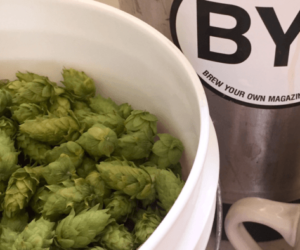Cellaring Beer: Tips from the Pros
Wine isn’t the only fermented beverage that can improve with age. Many high-alcohol and sour beers change for the better after a few months in a proper cellar. in this issue, two beer bar experts share some aging advice.
Molly Gunn, Co-Owner of The Porter Beer Bar in Atlanta, Georgia. Molly Gunn was born and raised in Atlanta, and her first restaurant job was at Babette’s Cafe on Highland Ave, where she bussed tables. She received a BA in cultural anthropology from the University of Pennsylvania in 2003 and worked in the restaurant business in Philadelphia, Washington, DC and Boston before returning to Atlanta in 2005. The Porter Beer Bar opened in September 2008. Molly is head of marketing, accounting, and the front of the house, but she prefers to be called “Boss Lady.”
We are currently cellaring more than 300 different beers at The Porter Beer Bar. Our oldest beer right now is Gale’s Old Prize Ale from 1996. Most of our beers aging are best at about five years, though many sours can age for up to ten to fifteen years when they are kept in the right conditions.
Aging beer requires periodically tasting and evaulating the beers over time. Many of the beers we have had come through the beer cellar are among those that we have already aged and experimented with at some point, so we know when their peak is and when they begin to decline.We revisit and taste unfamiliar beers every year to check on their progress. If it’s a style we haven’t cellared before we will taste it every six months. If we have cellared lots of of the same style of beer and feel confident it will take many years to age, we may only taste it once a year. We take notes so we help our servers give folks an idea of what they are ordering.
Maintaining a consistent temperature is key to cellaring beer, but a regular home refrigerator is the last place you want to store beer for a long time. If the beer is corked — which is the case for many bottle-aged beers — a refrigerator will eventually dry out the cork and the beer will oxidize. If you want to get into aging at home, a dark, cool closet is the best spot if you don’t have access to a temperature-controlled cellar. Wine refrigerators can also do the trick. We keep the cellar at Porter Beer Bar between 60–65 °F (15–18 °C) all the time. We don’t have different zones for different beers — though if you keep beer warmer it will age faster — but we are generally going for longevity rather than speed.
There is debate out there about standing beers up or laying them down like wine when they are in the cellar, but I prefer to keep bottled beers standing up when cellaring. Beer has yeast and sediment in it and if you lay them down it forms a much longer ring around the bottle so it’s more difficult for the beer to “remix” when you are pouring it. All wine that’s suitable for aging — with the exception of sparkling wine — has a porous cork, so wine is aging by slowly being exposed to air and interacting with the outside environment while beer is aging within the bottle for the most part and changing due to its bottle conditioning.
If you’re looking for some guidelines about what to age, there are a few simple rules to follow when you start out. Remember that the beers that are best to cellar are above 8% alcohol by volume (ABV). The only exception to that ABV rule is for sour beers, which can be much lower gravity and age much longer. Also remember that hops in a beer will fade into malty sweetness over time. If that’s what you want, that’s cool, but just because something is rare doesn’t make it best to age. This is why many hop-heavy IPAs and imperial IPAs aren’t necessarily great for aging. I once drank a year-old Hopslam from Bell’s Brewery in Kalamazoo, Michigan, and it was pure sweet honey, not a hint of bitter hop left. This is also true for many fruit beers. Bright fresh flavors of fruit dull with time. You can get some of the sweetness but the subtleties that let you know it’s pear and not apricot dissapear. Also, the beers you cellar should be bottle conditioned. Otherwise it won’t change much for many years.
Erich LaSher, Owner/Resident Wino and Beer Nerd at La Cave du Vin in Cleveland Heights, Ohio. La Cave du Vin opened in 1995 and was the first bar in Cleveland to only serve craft beer. It has been consistently rated highly as one of the best beer bars in the world by Ratebeer.com and Draft
magazine.
At any given time we will have at least a couple of hundred bottles of vintage beers in the La Cave beer cellar. We keep our cellar at about 55 °F
(13 °C) all year round, which is the perfect cellar temperature and also a great drinking temperature.
Aging beer is all about experimenting and having fun. If you have a network of other people who age beer on the internet they will help you make decisions about when to pull a beer, but otherwise it’s really all a matter of remembering when you put them in and experimenting.
Just like with wine, cellaring beer does not make a beer better, it makes it different. You may or may not like what that beer turns into when it ages. A lot of people don’t like those secondary characteristics that happen with time. For example, for me it seems like some bottles, like Thomas Hardy Ale, seem like they can’t age enough — but then I have tastings with fresh bottles and people like that way better. If you like something and want to lay it down, buy a bunch and try it every six months. But for god’s sake, don’t let it sit there forever.
One of the biggest mistakes I see with beer aging is cellaring the wrong stuff. Even if a brewery says that a beer is good for cellaring, it’s all about what you like. Some beers just lose their moxie after even a year.
If you want to cellar beer at home, remember that light is the enemy — you want a place that is dark, cool and dry (at least this is what has worked best for me). You also need to be able to maintain a constant temperature. Keep in mind, though — most beer is a lot more stable than people give it credit for. If you get a beer that was imported from Belgium it’s already been through hell and back — god only knows what happened to it during shipping.





